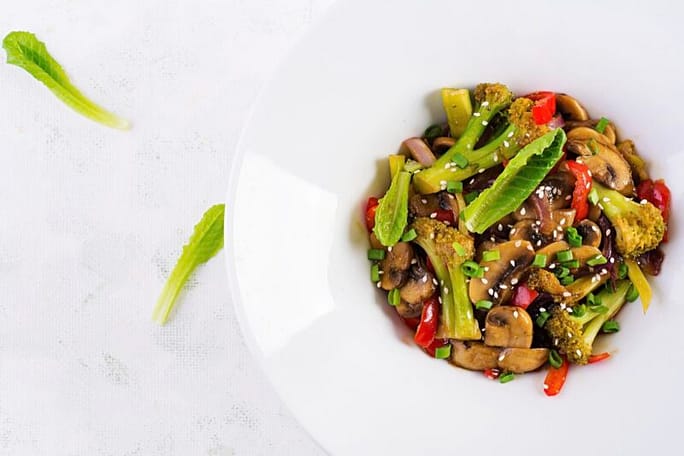Separating Fact from Fiction in Vegan Ingredients is the enlightening process of unraveling the truth behind plant-based components. Dive into the journey of discovering the real story behind the foods we choose, promoting a future of wellness where the clarity gained takes center stage.
I. Introduction
As the world embraces healthier and more sustainable lifestyles, the popularity of veganism and plant-based diets has surged. Amidst this cultural shift, the significance of understanding the true health implications of vegan ingredients cannot be overlooked.
We embark on a journey to dispel myths and unravel scientific truths about plant-based foods. From the nutrient-rich profile of vegan ingredients to their potential health benefits and ethical considerations, we explore the compelling evidence that underpins their role in fostering well-being and a greener planet.
Whether you're a seasoned vegan or a curious enthusiast, join me as we navigate through Separating Fact from Fiction in Vegan Ingredients where delicious food meets conscious living.
II. Separating Fact from Fiction in Vegan Ingredients
Common misconceptions about vegan diets and health include:
A. Inadequate Protein Intake
Here are some solutions for the common misconception of inadequate protein intake in vegan diets:
1. Diverse Protein Sources
Encourage a variety of plant-based protein sources such as beans, lentils, chickpeas, tofu, tempeh, and seitan to ensure you get a range of essential amino acids.
2. Include Nuts and Seeds
Incorporate nuts (e.g., almonds, peanuts) and seeds (e.g., chia seeds, hemp seeds) into your diet as they provide protein and healthy fats.
3. Whole Grains
Choose whole grains like quinoa, brown rice, and oats, which not only offer protein but also fiber and other nutrients.
4. Veggie Burgers and Meat Alternatives
Enjoy plant-based meat alternatives (read my blog post about it) like veggie burgers and mock meats for a convenient protein boost.
5. Supplements
Consider vegan protein supplements like pea protein or rice protein powder if you have difficulty meeting your protein requirements through whole foods.
6. Balanced Meals
Ensure your meals consist of a balance of protein, carbohydrates, and healthy fats for overall nutrition.
7. Consult a Dietitian
If you have concerns about your protein intake, consult a registered dietitian with expertise in vegan nutrition to create a personalized plan.
By following these solutions, individuals on a vegan diet can address the misconception of inadequate protein intake and maintain a healthy, well-rounded diet.
B. Nutritional Deficiencies
Addressing nutritional deficiencies is crucial for maintaining a healthy vegan diet. Here are some solutions for common nutritional deficiencies in vegan diets:
1. Vitamin B12
Take a B12 supplement or consume fortified foods like plant-based milk, cereals, and nutritional yeast.
2. Iron
Include iron-rich foods such as beans, lentils, tofu, and fortified cereals. Consume vitamin C-rich foods to enhance iron absorption.
3. Calcium
Consume calcium-fortified plant milk, leafy greens (e.g., kale, collard greens), and fortified orange juice.
4. Omega-3 Fatty Acids
Include flaxseeds, chia seeds, and walnuts for ALA omega-3s. Consider algae-based DHA/EPA supplements.
5. Vitamin D
Get regular sun exposure and consider a vitamin D supplement, especially if you have limited sun exposure.
6. Iodine
Use iodized salt or consume seaweed (in moderation) and iodine-rich foods like cranberries and potatoes.
7. Protein
Diversify protein sources, including legumes, tofu, tempeh, and mock meats. Monitor your protein intake to ensure adequacy.
8. Zinc
Consume zinc-rich foods like nuts, seeds, and whole grains. Ensure balanced meals with sufficient zinc.
9. Selenium
Incorporate selenium-rich foods like Brazil nuts, brown rice, and whole wheat bread.
10. Vitamin K2
Consume natto (fermented soybeans) or consider a K2 supplement if necessary.
11. Folate
Include folate-rich foods like leafy greens, beans, and fortified cereals.
Balancing your diet with a wide variety of nutrient-dense foods, considering fortified options, and, if necessary, consulting a registered dietitian with expertise in vegan nutrition can help address and prevent nutritional deficiencies in a vegan diet.
C. Weakness and Fatigue
Weakness and fatigue can result from various factors in a vegan diet. Here are some solutions to address and prevent these issues:
1. Iron-Rich Foods
Consume iron-rich plant foods like lentils, beans, tofu, and fortified cereals. Pair them with vitamin C-rich foods to enhance iron absorption.
2. B12 Supplementation
Take a vitamin B12 supplement to prevent anemia, which can cause fatigue.
3. Adequate Calories
Ensure you're consuming enough calories and not unintentionally undereating.
4. Protein Balance
Maintain a balanced protein intake through plant-based sources like legumes (know more about it in my blog post), nuts, seeds, and whole grains.
5. Healthy Fats
Incorporate sources of healthy fats like avocados, nuts, and seeds for sustained energy.
6. Omega-3 Fatty Acids
Include foods rich in ALA omega-3s, such as flaxseeds and chia seeds.
7. Hydration
Drink enough water throughout the day to prevent dehydration, which can lead to fatigue.
8. Adequate Sleep
Ensure you're getting sufficient rest, aiming for 7-9 hours of quality sleep each night.
9. Stress Management
Practice stress-reduction techniques like meditation, yoga, or deep breathing exercises.
10. Consult a Healthcare Professional
If fatigue persists, consult a healthcare professional to rule out any underlying medical issues or nutrient deficiencies.
By incorporating these solutions, you can help combat weakness and fatigue in your vegan diet and maintain a balanced and energized lifestyle.

D. Limited Food Choices
Dealing with limited food choices on a vegan diet can be challenging, but there are solutions to make your meals more varied and enjoyable:
1. Explore Ethnic Cuisines
Different cultures offer a wide range of vegan options. Try dishes from Indian, Thai, Mexican, or Mediterranean cuisines, which often have plant-based options.
2. Experiment with New Ingredients
Be open to trying new vegan ingredients like tempeh, jackfruit, or nutritional yeast to diversify your meals.
3. Cook at Home
Preparing your meals allows you to have more control over the ingredients and experiment with different recipes.
4. Grow Your Vegetables
If possible, start a small herb or vegetable garden to grow your fresh ingredients.
5. Seek Out Vegan Restaurants
Many cities now have vegan or vegan-friendly restaurants, so explore these options for a variety of choices.
6. Use Plant-Based Substitutes
Explore plant-based alternatives for dairy, meat, and other animal products, which can expand your food choices.
7. Join Vegan Communities
Connect with other vegans through local or online communities to share recipes and meal ideas.
8. Plan Balanced Meals
Ensure that each meal includes a balance of protein, carbohydrates, and healthy fats for variety and nutrition.
9. Meal Prepping
Prepare meals in advance to save time and ensure you have a variety of options ready to eat.
10. Consult a Dietitian
A registered dietitian with expertise in vegan nutrition can help you plan balanced, diverse meals.
By implementing these solutions, you can overcome the challenge of limited food choices and enjoy a more varied and satisfying vegan diet.
E. Lower Bone Density
Maintaining healthy bone density on a vegan diet is essential. Here are some solutions to address and prevent lower bone density:
1. Calcium-Rich Foods
Consume calcium-rich plant foods, including fortified plant-based milk, leafy greens (e.g., kale, collard greens), and fortified orange juice.
2. Vitamin D
Ensure you get adequate vitamin D, either through sun exposure or supplements, as it is vital for calcium absorption.
3. Weight-Bearing Exercise
Engage in weight-bearing exercises like walking, jogging, or strength training to promote bone health.
4. Adequate Protein
Ensure you have enough protein in your diet, as protein is essential for bone health. Include sources like legumes, tofu, and tempeh.
5. Omega-3 Fatty Acids
Incorporate sources of ALA omega-3s like flaxseeds and chia seeds for their anti-inflammatory benefits.
6. Limit Caffeine and Salt
Excess caffeine and salt can lead to calcium loss from bones. Moderation is key.
7. Minimize Phytic Acid
Phytic acid, found in certain plant foods, can inhibit mineral absorption. Soak, sprout, or ferment grains and legumes to reduce phytic acid content.
8. Supplements
If needed, consider calcium and vitamin D supplements after consulting a healthcare professional.
9. Regular Check-Ups
Schedule bone density scans to monitor your bone health and make necessary adjustments to your diet and lifestyle.
10. Consult a Dietitian
A registered dietitian with expertise in vegan nutrition can help you create a bone-healthy diet plan.
By following these solutions, you can help maintain and improve your bone density while following a vegan diet.
F. Difficulty in Building Muscle
Building muscle on a vegan diet is achievable with the right approach. Here are some solutions to address difficulty in building muscle:
1. Adequate Protein
Ensure you're getting enough protein from plant-based sources like legumes, tofu, tempeh, seitan, and plant-based protein powders.
2. Balanced Diet
Consume a well-rounded diet that includes a variety of plant-based foods to provide essential nutrients.
3. Strength Training
Engage in regular strength training exercises to stimulate muscle growth. Use a mix of bodyweight exercises and weights.
4. Caloric Surplus
Ensure you're consuming enough calories to support muscle growth. Calculate your maintenance calories and add a surplus for muscle building.
5. Protein Timing
Consume protein before and after your workouts to support muscle repair and growth.
6. Supplements
Consider plant-based protein supplements, creatine, and BCAAs (branched-chain amino acids) if needed, after consulting a healthcare professional.
7. Hydration
Stay well-hydrated, as water is essential for muscle function and recovery.
8. Rest and Recovery
Give your muscles time to recover through adequate sleep and rest days between workouts.
9. Consult a Dietitian
A registered dietitian with expertise in vegan nutrition can help you create a muscle-building meal plan.
10. Track Progress
Keep a record of your workouts and dietary intake to make necessary adjustments and track your progress.
With these solutions, you can effectively build muscle on a vegan diet, provided you pay attention to your nutritional intake and maintain a consistent exercise routine.

G. Lack of Flavor
Enhancing the flavor of vegan dishes is key to making your meals more enjoyable. Here are some solutions to combat a lack of flavor in your vegan cooking:
1. Herbs and Spices
Experiment with herbs and spices to add depth and complexity to your dishes. Options like garlic, ginger, basil, and cumin can transform flavors.
2. Citrus Zest and Juice
Citrus fruits like lemon and lime provide a burst of freshness and acidity to brighten up your meals.
3. Umami Ingredients
Incorporate umami-rich foods such as mushrooms, nutritional yeast, soy sauce, or miso for savory depth.
4. Roasting and Grilling
Roast or grill vegetables to bring out their natural sweetness and enhance flavor.
5. Healthy Fats
Use healthy fats like avocado, nuts, and olive oil to add richness and mouthfeel to your dishes.
6. Vinegar
Balsamic, apple cider, and other flavored vinegars can provide a tangy, acidic element to your meals.
7. Plant-Based Condiments
Explore vegan condiments like tahini, hummus, or dairy-free pesto for added flavor.
8. Marinades and Sauces
Marinate proteins and vegetables with flavorful sauces before cooking to infuse them with taste.
9. Experiment
Don't be afraid to experiment with different flavor combinations to find what you enjoy.
10. Cooking Techniques
Explore cooking techniques like sautéing, caramelizing, or reducing to intensify flavors.
11. Texture Variety
Incorporate a variety of textures in your dishes to make them more interesting and enjoyable.
12. Recipe Inspiration
Search for vegan recipes and cookbooks that offer creative and flavorful ideas.
By implementing these solutions, you can add depth, complexity, and excitement to your vegan dishes, making them more flavorful and satisfying.
H. Expensive
Eating a vegan diet can sometimes be expensive, but there are ways to manage costs. Here are some solutions to make your vegan diet more affordable:
1. Buy in Bulk
Purchase non-perishable items like grains, legumes, and canned goods in bulk to save money in the long run.
2. Seasonal and Local Produce
Choose seasonal and locally grown fruits and vegetables, which are often more affordable and fresher.
3. Frozen Fruits and Vegetables
Frozen produce is a cost-effective and convenient option, with a long shelf life.
4. Store Brands
Consider buying store-brand or generic products, which are typically more affordable than name brands.
5. Meal Planning
Plan your meals and create a shopping list to avoid impulsive purchases and reduce food waste.
6. Cook at Home
Preparing meals from scratch is usually more cost-effective than eating out or buying pre-packaged meals.
7. Plant-Based Proteins
Opt for budget-friendly plant-based proteins (know more about them in my blog post) like beans, lentils, tofu, and tempeh.
8. DIY Snacks
Make snacks like granola bars or trail mix, which can be less expensive than pre-packaged options.
9. Canned and Dried Foods
Utilize canned and dried beans, lentils, and grains, which are affordable and versatile.
10. Leftovers
Repurpose leftovers to create new meals and reduce food waste.
11. Herbs and Vegetables gardening
If you have space, consider growing your herbs and some vegetables at home.
12. Discounts and Coupons
Keep an eye out for discounts, sales, and coupons on plant-based products.
13. Community Support
Join a local community garden or food co-op to access affordable, fresh produce.
14. Online Resources
Utilize online resources and apps that offer discounts and deals on vegan products.
By applying these solutions, you can manage the cost of a vegan diet and make it more budget-friendly while still enjoying nutritious and delicious meals.

III. Additional References
- The Association between Vegan Dietary Patterns and Physical Activity—A Cross-Sectional Online Survey (2023) https://www.ncbi.nlm.nih.gov/pmc/articles/PMC10145789/
- Nutrient Intake and Nutrition Status in Vegetarians and Vegans in Comparison to Omnivores - the Nutritional Evaluation (NuEva) Study (2022) https://www.ncbi.nlm.nih.gov/pmc/articles/PMC9149309/
- Consumption of meat and dairy substitute products amongst vegans, vegetarians and pescatarians (2023) https://www.ncbi.nlm.nih.gov/pmc/articles/PMC10084502/
IV. Conclusion
The voyage into the world of vegan ingredients has been a truly transformative experience. By diving deep into the intricacies of plant-based components, we've unraveled the myths surrounding them and paved the way for a more conscious and informed dietary lifestyle. Through this exploration, we empower ourselves to make choices that align with both our well-being and the greater environmental good.
The process of Separating Fact from Fiction in Vegan Ingredients involves careful consideration of nutritional realities, dispelling misconceptions, and embracing the authenticity of the plant-based offerings. As we navigate this path, it becomes evident that each ingredient carries a unique story, a truth waiting to be uncovered and appreciated.
Let the gained clarity be a guiding light toward a future where the authenticity of vegan ingredients takes center stage. This journey is not just about dispelling myths but fostering a deep understanding of the foods we choose to nourish our bodies. It is an ongoing commitment to wellness, where nutritional truths are celebrated, and individuals are empowered to make mindful choices for a healthier and more sustainable world.
As we conclude this exploration, may the journey of Separating Fact from Fiction in Vegan Ingredients continue to inspire, enlighten, and shape a future where the inherent truths of plant-based living lead us to a richer, more vibrant state of well-being.
V. My Experience
The journey of Separating Fact from Fiction in Vegan Ingredients has been nothing short of fascinating. I've always had a penchant for trying out new and unusual foods, and that curiosity led me to explore the world of vegan cuisine, despite not being a vegan myself.
The allure of its health benefits and the promise of an intriguing taste profile were too enticing to resist. I've found that venturing into the world of vegan ingredients has not only broadened my culinary horizons but has also provided a fresh perspective on making mindful and nutritious choices.
So, even if you're not a vegan, I encourage you to embrace the adventure and discover the unique flavors that vegan food has to offer – it's a journey of exploration, health, and, most importantly, flavor.
Also, consider including Black rice in your meals, read more about it in my blog post.
Embark on more enlightening journeys with our diverse range of blog posts!
Explore further, discover, and share your experiences with us. Your insights and discoveries enrich our community, fostering a collective journey towards mindful and nourishing living. Let's connect and learn together!
